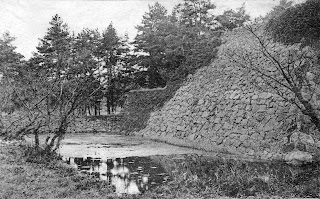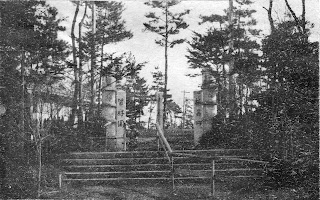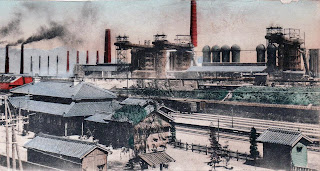The Narrows from Kiyotaki-koen
Moji Harbour
Duly installed at Ishida Kwan, a comfortable Japanese hostel, the Pilgrim for the time being, loses his identity as such and becomes known to all and sundry as “juroku-ban;” -16 being the number of his room and the name or the first syllable thereof, having no reference whatever, to the shape or size of his nose or the keenness he displayed in striking the preliminary bargain. After a bath, followed by a very good dinner, the Pilgrim sallied forth to see the town. But what a different Moji! So many changes seem to have taken place during the last decade; “improvements,” involving the obliteration of once familiar landmarks, that one fails to recognise the place.
No 2. Hatoba (pier)
Moji Town and Harbour
Moji in the 1860s
The small shops also, that fronted this street seem to have been “improved” out of existence, as nowadays their sites are occupied by fine up-to-date business establishments on this, the main business thoroughfare, up and down which an excellent service of electric cars is maintained.
Bird's Eye View of Moji
Wakamatsu Habour near Moji
Considering the fact that less than forty years ago, Shimonoseki was the port and Yuji a mere fishing village, the development of the latter place is a remarkable and highly ereditable illustration of Japanese industrial progress. The Asano cement works, which the Pilgrim remembers as a comparatively small affair with, at the most, half a dozen chimneys, nowadays is a huge undertaking, occupying a large area, with row upon row of smoking kilns.
The Pilgrim's stay at Moji was too brief to permit of his revisiting Kiyotaki Koen, the public garden from which a fine view of the surrounding scenery may be obtained and, for a similar reason, Mekari-Jinsha, a temple connected wherewith are many pleasant personal associations, was not visited.
Mekari-Jinsha, from the beach
From the grounds of this temple, situated as they are on the extreme northern point of Kyushu, the view of the Straits and the western entrance to the Inland Sea, with the mountains in the background is extremely picturesque.
Moji harbour and waterfront also seemed different, the changed appearance probably being due to the lack of shipping, as in place of the many liners at anchor, cargo steamers loading coal or bunkering; owing to the demand for British and Allied tonnage elsewere, there were few foreign vessels in port and of these, all flew an alleged “neutral” flag.
Along the Moji Waterfront
The Asano Cement Works
Osaka Shosen Kaisha Pier
O.S.K. Wharf
Hayatomo Beach
Moji
The Custom House
Down a side street away from the region of bright lights, music and hilarity, the following remarkable legend was observed:—
To the best of his recollection, the Pilgrim has never had his hair cut by a “graduate” and the opportunity of acquiring yet another novel experience appeared too good a one to be missed, but the Fates seemingly had destined it otherwise; Graduates, it would seem are either shy or early birds, as the Tonsorial Emporium appeared to be closed for the day and thus another burning desire had to remain ungratified.
This signboard leads one furiously to think. Apparently there are Schools and Curriculums of which the average man wots not, as a degree in the Art (or Science?) of haircutting is somewhat of a novelty. But this is Taisho, the era of progress, and mayhap some day it may be the good fortune of the Pilgrim, ere he finally lays down his staff and scrip, and discards his palm and cockle shells, to have his thirst assuaged by a graduate ‘barkeep,’ or his boots clearned by a ditto shineofaciste.
Among the many beneficial result of Japan's excellent scheme of intensive education, such an event is not wildly improbable and judging by the number of schools, existent and in course of erection which are to be seen everyhere; in another decade or so, the Japanese will - or at least, ought to - rank with the best educated peoples of the world. “Knowledge is power,” so runs the old copy-book maxim, hence having ‘got’ (or gotten, as our American cousins prefer it) :
“The ships, and got the men, and, (recently) Has got the money too,”
with that Power, incident upon the acquisition of knowledge, Japan need have no fear for her future, always providing that all is well within her gates.
But a cloud has risen above her political horizon in her Labour question and the question, although not yet acute, must occasion grave anxiety to her rulers, as throughout the world Demos is awake and fully aware of his value to the State. To a superficial observer, unskilled in the Science of economics Japanese Labour appears to receive a miserable pittance for its inestimable services to the Nation. Far-seeing employers appear to have accorded a tardy recognition of the fact and, as a sop to the Democratic Cerberus, - presumably, in the hope of postponing the inevitable day of reckoning, - they have granted slight increases of pay to their employees. Meanwhile the cost of living is rising steadily and thereby accelerating the advent of settling day.
The old machi at the back of the town appeared to be little, if at all, changed; possibly there is more electric light used now-a-days but otherwise the streets are as narrow, bustling and interesting as ever.
Anent the otherwise excellent electric car service, two objectionable features must be noted. The headlight, the glare of which is much too brilliant, blinds pedestrians, and in place of the warning bell, the cars are fitted with a whistle operated by compressed air, which makes as much row as the whistle of a steam launch and is altogether far too loud and piercing. The Tramway Company, as elsewhere in Japan, appear to have more consideration for the welfare of the employees, despite the fact that the extremes of climate are not so rigorous, than the case in Shanghai.
This care for the welfare of the motorman and conductor, is evinced even in the smaller towns, as the front and rear platforms of the cars are always boxed in and glazed, thus protecting them from the inclemency of the weather, while at the same time not interfering with the efficient performance of their respective duties. Another notable feature in Japan appears to be the fact that Regulations are promulgated with the expectation that they will be observed and while it appears to be superfluous to decorate the interior of the car with notice “No spitting allowed,” the printed prohibition of smoking is strictly enforced.
Another remarkable feature observed in the Moji streets is the limited number of rickshaws, either in actual use, or in on the licensed stands. Hence, it is evident that the trams do most of the local passenger transportation. Bicycles, however, are as prevalent as elsewhere and, incidentally, are a great a nuisance to the ordinary pedestrian.
Pictures of Moji
Moji Yukaku "Y.M.C.A."
The Y.M.C.A. (Young Men's Coddling Assn.)
The Kaigan-dori
Temple of Hachiman
Higashi Hon Machi
Nishi Honcho-dori
The round is soon completed and the Pilgrim returns to his hotel there to complete his preparations for an early start on the morrow.
The Babayukaku Barrier - The Manger, Wild Oats for Wild Asses "YMCA"
Yes, Moji has changed; although seen from the hotel verandah previous to retiring, the lights on the hill glow just as brightly through their crimson paper lamps and look just as pretty and as alluring as ever. But a younger generation of wassailers nowadays plays its part in the ever-green tragi-comedy of the Prodigal Son Up-to-date, and while knocking out the “dottle” of his last pipe for the night, the Pilgrim wonders somewhat sadly what has become of that merry and irresponsible band, which foregathered where lamps and eyes glowed brightly in those bygone mad but merry days. Ehu! Fugaces labuutur anni! (Alas our fleeting years pass away, ed.)
"That Merry and Irresponsible Band"
Drawing the shoji together and shutting out the view, the Pilgrim sets about his nightly task of working out the train service and connections for the ensuing day's lap - Moji to Miyajima on this occasion - previous to issuing orders anent 6 being called betimes. “And so to bed.” The Pilgrim turns into his comfortable futon therein to sleep soundly.
Note: Moji - Important coal export port - northern terminus of the Kyushu branch of Imperial Govt. Railways. It is 164 miles from Nagasaki and connects by ferry with Shimonoseki across the straits. It is the western entrance of Inland Sea and exceedingly picturesque in scenery.
Shimonoseki
Kanmon Renraku
Sanyo Hotel
Kameyama Insetsuji
The Railway Station
Heiken-no-mori
Genpei, Dannoura
Other Photographs
Kaimondake, Kagoshima
"Bright Sights, Eyes, Music and Hilarity"
Playing Koto
Shitsukeigen
Arishiyama, Kyoto
Five O'Clock Tea
















































_edited-2.jpg)

















